

NARRATOR: As we gather together for the 1997 Loonan/Bedford Reunion
in Falls Church, Virginia, we would like to celebrate our heritage by thinking
about our ancestors in their historical context. In the production that
follows, you will learn about Elizabeth "Besse" Bedford Loonan and Lloyd
James Loonan and their parents and grandparents. We will try to give you
a sense of how they lived by showing some things they owned and describing
what was happening in the world when they were alive. Our story spans nearly
2 centuries, a time of tremendous innovation and change in the world. Our
players are the children and grandchildren of Besse and Lloyd. (Actors
introduce themselves)
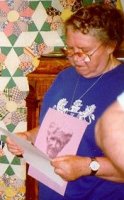
Those with yellow nametags represent the Bedford side of the family,
and those with lavender nametags represent the Loonan side of the family.
They will be using these tokens to pinpoint their location in the world
at any given time (show tokens or map pins).
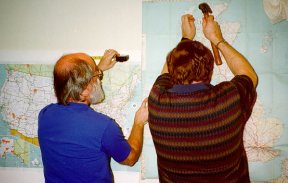
Our story begins in 1809. In this year Mary Hague is born March 31 in Saddleworth, England. (Enter Mary, wearing yellow nametag, who waves) By coincidence, her spouse-to-be Joseph Whiteley is born that same year on Sept. 4 in Huntersfield, England. (Enter Joseph, wearing yellow nametag, who waves). (Each places token on birthplace on map of England.)
NEWSREADER: All of Europe is in a state of unrest. Napoleon and his armies, having invaded several countries, are forcing the invaded countries to sign treaties blockading the British Isles and boycotting British goods. U.S. President James Madison has reinstated an embargo on British trade because Britain has refused to revoke laws that allow harassment of American shipping (a prelude to the War of 1812).
NARRATOR: Next, we meet Lydia Molyneux, born Sept. 1, 1820, in Manchester, England. (Enter Lydia, wearing yellow nametag, who waves and places token on map of England.) Her father William is a weaver. William has traveled to America and was the first settler of Sullivan County, Pennsylvania in 1794. He has returned to England and will later go back to Pennsylvania with his family.
Lydia’s spouse-to-be Jonas Bedford is also born in 1820, on November 3, in Briestfield, Yorkshire, England. (Enter Jonas, wearing yellow nametag, who waves and places token on birthplace on map of England.)
NEWSREADER: By this time, Napoleon has been defeated, and most European countries have been returned to their pre-Napoleonic borders. George IV is king of England, and James Monroe is president of the U.S. The Savannah has crossed the Atlantic from Georgia to Liverpool, the first ship to use partly steam power. English scientist Michael Faraday invents the electric motor. In 1823 American Cyrus McCormick invents the horse-drawn reaper-harvester, making it possible to harvest crops at 3 times the previous speed. The first railway for steam locomotives is opened in England in 1825. The first railway in the U.S. opens in 1826 in Quincy, Massachusetts.
NARRATOR: It's 1828 now, and our original couple, Mary Hague and Joseph Whitely, having reached the ripe old age of 19, are married on Dec. 21 in Saddleworth, England. (Mary and Joseph join hands, wave. Joseph moves his token to Saddleworth.)
Meanwhile, the families of Lydia Molyneux and Jonas Bedford emigrate from England to Sullivan County, Pennsylvania. (Lydia and Jonas move tokens to Sullivan County on map.) Jonas' family take with them the Bedford family bible. [Show bible]
NEWSREADER: Andrew Jackson is elected president of the U.S. in this year, defeating his long-time rival John Quincy Adams, the sitting president. In 1829, a Workingman's Party is formed in New York, the beginning of the labor movement in the U.S. The "Workies" campaign for the reduction of the work day to 10 hours, free education for all, and free public land among other things. Noah Webster publishes The American Dictionary of the English Language. The first passenger railway line is opened in Maryland.
In 1830, the U.S. Congress passes the Indian Removal Act, exiling native Americans to the area west of the Mississippi River. The tribes are to receive perpetual title to lands in the west, financial assistance and a government guarantee of security. The first covered wagons arrive in California, having used southern routes to cross the Rockies. The disease cholera spreads through Europe.
NARRATOR: Now we turn briefly to the Loonan side of the family. It's 1831, and James Vaughan is born on November 6 in Monmouthshire, Wales, the seventh in a family of 10 children. (Enter James, wearing a lavender nametag, who waves and places token on Monmouthshire on the map)
NEWSREADER: In 1832, an expedition discovers the source of the Mississippi River. The cholera epidemic makes its way to America; 4000 people die of the disease in New York City.
NARRATOR: Thomas Loonan is born April 4, 1833, in Kings County (now Offaly) near Dublin, Ireland. (Enter Thomas, wearing a lavender nametag, who waves and places token on Kings County on map)
NEWSREADER: It’s 1834. Cyrus Hall McCormick invents a new automatic grain-reaping machine that will multiply the U.S. agricultural industry's productivity.
NARRATOR: Emily P. Redman, James Vaughan's future wife, is born May 23, 1836, in Henderson County, Illinois. (Enter Emily, wearing lavender nametag, who waves and places token on Henderson County on map) Her father, Colonel Reason Redman, served in the War of 1812 against the British and owned land that later became Burlington, Iowa.
NEWSREADER: In 1836, Mexican troops slaughter the Texan defenders at the Alamo. President Andrew Jackson dies in office, and Martin van Buren is elected president -- the first U.S. president without a British family name. Samuel Morse invents the Morse code. 15,000 Dakota Indians die of smallpox in 1837. Victoria becomes queen of England. In 1838, the first ship crosses the Atlantic Ocean entirely by steam power.
NARRATOR: Back in Britain, it's 1839, and Catherine Glenny, future wife of Thomas Loonan, is born February 1 near Coolaney southwest of Sligo in Ireland. (Enter Catherine, wearing lavender nametag, who waves and places token on Sligo County on map) She is the daughter of James and Maria Armstrong Glenny.
NEWSREADER: The daguerreotype is invented in Paris. This is an example of a daguerreotype. [Show sample] An English scientist invents "photogenic drawing," which uses light-sensitive paper negatives to make photographic prints. A patent is granted in London for an electric telegraph.
NARRATOR: The following year, 1840, Joseph and Mary Whiteley emigrate from England to the U.S., where they live for a time in Philadelphia, and then settle on a farm in Sullivan County, Pennsylvania. One of the treasures they brought is this coverlet. [Show coverlet] (Mary and Joseph move tokens to Sullivan County on map of U.S.) Notice the seam in the middle of the coverlet. The seam was necessary because the looms used to weave coverlets were only half the coverlet's width.
NEWSREADER: In 1840, Anglo-Canadian shipowner Samuel Cunard founds the first regular steamship line from Liverpool to Boston and New York. A universal, inexpensive postal system is developed in Great Britain; for just a penny a letter weighing half an ounce may be sent anywhere in the realm.
In 1842, in Britain, the adding machine is invented, and the Mines Act is passed, prohibiting the employment underground of women, girls and children under 10 year old.
NARRATOR: It's 1843. Jonas Bedford marries Lydia Molyneux on May 25 in Sullivan County, Pennsylvania. They will have 10 children during their marriage, and the family will be involved in helping former slaves via the Underground Railroad. Jonas will serve in the Civil War as a private in the Second Pennsylvania Artillery. Our forebear Daniel Bedford is born to them on July 2, 1845, in Forksville, Pennsylvania. (Enter Daniel, wearing yellow nametag, who waves and places token on the map)
NEWSREADER: In 1846 Iowa is admitted to the Union; it is the 19th non-slave state in the U.S. The California Gold Rush occurs in 1846. Karl Marx and Friedrich Engels publish "The Communist Manifesto" in 1848. That same year, the first all-women convention on women's rights is convened in Seneca Falls, New York, resulting in demands for universal suffrage and an end to religious and social discrimination against women.
In Ireland, police arrest one of the leaders of the Irish Confederation, thereby squelching the Confederation's hopes of an Irish nationalist uprising; most Irish peasants are too preoccupied with surviving the potato famine that began in 1846 to notice.
NARRATOR: On the Bedford side of the family, Martha Whiteley is born May 7, 1849, in Forksville, Sullivan County, Pennsylvania. (Enter Martha, wearing yellow nametag, who waves and places token on Sullivan County) Later in life, Martha becomes a schoolteacher.
Our story now returns to the British Isles. On the Loonan side of the family, James Vaughan emigrates to the U.S. from Wales in 1849 at the age of 18, carrying his belongings in this pine box. He goes first to Philadelphia, then to Hamilton County, Ohio. (James moves token to Hamilton County, Ohio on U.S. map) There he works as a farm laborer for 3 years. In 1850 his parents and siblings also emigrate to Hamilton County from Wales. James (the father) dies of cholera 2 weeks after his arrival in America. His wife Catherine owned this walnut table and later gave it to son James. [Show pine box and walnut table]In 1851, at the age of 11, Catherine Glenny emigrates to the U.S. from Ireland. Her family is very poor because of the potato famine. To pay her passage her family sends her to work for 5 years for a family in Dubuque, Iowa. The journey to America takes 6 weeks, and the only food Catherine has to eat is a barrel of fish. About one person in every 6 dies at sea. Catherine survives and sails to New Orleans, then up the Mississippi River to Dubuque. (Catherine traces route on map) A year later, in 1852, Thomas Loonan, Catherine's future husband, emigrates from Ireland to the U.S. at the age of 19, landing in New York City on May 15. He becomes a farm laborer in Chester County, Pennsylvania, then moves to Winnebago County, Illinois. (Thomas moves token to Chester County, PA and Winnebago County, IL on map)
NEWSREADER: At this time, the slavery issue is dividing American states. Bitter divisions surface at the annual convention of the Anti-Slavery Society. The sewing machine is invented in the U.S.
In England, the world's largest exhibition opens at Crystal Palace in London's Hyde Park. The exhibition is designed to pay tribute to the industrial advances that have given Britain unprecedented prosperity and economic mastery in the first half of the century.
NARRATOR: In 1855, James Vaughan marries Emily Redman in Henderson County,
Illinois, where they operate a farm.

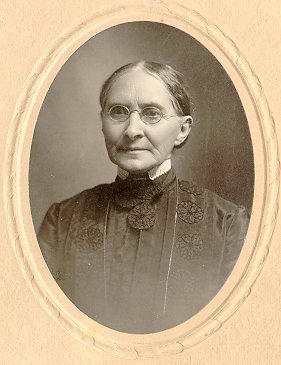 They have 9 children during their
marriage. (James and Emily join hands and move tokens to Henderson County
on map) This spice cabinet was owned by Emily and James Vaughan. [Show
photo]
They have 9 children during their
marriage. (James and Emily join hands and move tokens to Henderson County
on map) This spice cabinet was owned by Emily and James Vaughan. [Show
photo]
Meanwhile, after Catherine "Kate" Glenny has worked for the family in Dubuque for 5 years, her uncle comes to get her. She moves with him to Winnebago County, Illinois. (Catherine moves token to Winnebago County)In 1858, Thomas Loonan, at the age of 25, marries Catherine Glenny, age 18, in Winnebago County, Illinois. (Thomas and Catherine join hands) There Thomas works as a farmhand and Catherine bears 3 children. One of those children is James Loonan, born January 21, 1861. (Enter James, wearing lavender nametag, who waves and places token on Winnebago County on map)
NEWSREADER: The first Pony Express delivers 49 letters and 3 newspapers from Missouri to California in 1860. The new mail service involves riding a series of horses across 1,966 miles of desolate prairie with risks from both hostile Indians and flash floods in the mountains. Abraham Lincoln is elected the 16th U.S. president. South Carolina secedes from the union. The following year, other slave states secede and form the Confederate States of America. The Civil War begins.
In 1862 the Homestead Act is passed, offering every head of a family a 160-acre farm free of charge. Many immigrants to the U.S. head west, lured by the fertile farm country. World steel production is soaring following the invention of the Bessemer furnace.President Lincoln signs the Emancipation Proclamation in 1863, proclaiming the freedom of slaves in the confederate states. The Civil War death toll mounts. In the battle of Antietam in Maryland, 23,500 soldiers are killed in one day of fighting.
NARRATOR: In September, 1864, when son James is 3, Thomas and Kate Loonan
set out in covered wagons with 3 other families for Black Hawk County,
Iowa.
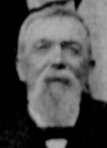
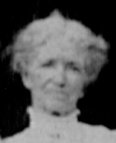 (Thomas, Catherine and James move tokens to Black Hawk County on
map) Thomas and Catherine purchase a 100-acre farm, where they raise cattle,
horses and hogs. They also buy stock, fitting it for market. Catherine
bears 4 more children, a total of 7. This photo shows Thomas and Catherine
with their children. [Show photo and point out son James.]
(Thomas, Catherine and James move tokens to Black Hawk County on
map) Thomas and Catherine purchase a 100-acre farm, where they raise cattle,
horses and hogs. They also buy stock, fitting it for market. Catherine
bears 4 more children, a total of 7. This photo shows Thomas and Catherine
with their children. [Show photo and point out son James.]
In this same year, 1864, their son James' future wife Elizabeth "Lizzie" Vaughan is born on January 9 in Henderson County, Illinois. (Enter Elizabeth, wearing a lavender nametag, who waves and places token on Henderson County on map) This bible, dated 1878, was owned by Lizzie [show bible].
NEWSREADER: On April 9, 1865, General Robert E. Lee surrenders to General Ulysses S. Grant at Appomattox, Virginia, and the Civil War ends. A total of 2 million Americans have died in the conflict. On April 15, President Lincoln is assassinated at Ford's Theatre in Washington, D.C. The Ku Klux Klan, dedicated to white supremacy, thrives in the former rebel states. The first post-war meeting of the National Women's Rights Convention is held in New York City; by unanimous vote, the American Equal Rights Association is formed. A transatlantic underwater cable is laid, making possible reliable telegraph communication between the U.S. and the British Isles.
In 1867, the U.S. purchases Alaska from Russia for $7.2 million. The 14th amendment to the U.S. Constitution is ratified in 1868, giving full U.S. citizenship to Negroes. The first railway dining car, invented by Thomas Pullman, comes into service, and the first patent is granted in the U.S. for a typewriter.
NARRATOR: James and Emily Vaughan, with daughter Elizabeth, age 5, move from Henderson County, Illinois, to Black Hawk County, Iowa in 1868. There they purchase a farm and continue to engage in raising cattle. (James, Emily and Elizabeth move tokens to Black Hawk County on map) James attends the common schools of Black Hawk County and the Gem City Business College of Quincy, Illinois.
NEWSREADER: East is joined to west in the U.S. in 1869 as the world's longest railroad is completed with the joining of the Central Pacific and the Union Pacific railroads in Utah. Women in the territory of Wyoming are given the vote.
NARRATOR: In 1871, Daniel Bedford, age 26, marries Martha Whiteley, age 22, on March 9 in Sullivan County, Pennsylvania. (Daniel and Martha join hands and wave) Daniel takes his bride to a farm he has purchased in Lincoln township in Iowa (the original Karkosh farm). Six children are born to them during the time they live on that farm. This photo is of Martha, and these photos show an oak desk, bread plates, egg cups and a mustache cup owned by Martha. [Show photos]
Sometime during the 1870s, Jonas and Lydia Bedford move from Pennsylvania to Nobles County, Minnesota. (Jonas and Lydia move tokens to Nobles County)
NEWSREADER: The national Women's Christian Temperance Union is formed in the U.S. in 1874. Two future members to be are Lizzie Vaughan Loonan and Besse Bedford Loonan. Chewing gum is invented in 1875.
NARRATOR: Joseph and Mary Whiteley move from Sullivan County, Pennsylvania to Forksville, Pennsylvania in 1875. (Joseph and Mary move tokens to Forksville) Sometime between 1875 and 1888, Joseph dies in Forksville. (Joseph removes his token from map)
NEWSREADER: Alexander Graham Bell invents the telephone in 1876. Thomas Edison invents the phonograph in 1877.
NARRATOR: On election day in 1878, Daniel Bedford is riding his favorite horse when it steps in a hole and falls upon Daniel’s leg, breaking it at the ankle. It is a compound fracture and as always, the injury begins to bleed in a few days. A consultation of doctors decide the only remedy is to amputate the limb. Daniel does not consent to such drastic measures, and it is as well he does not, for he recovers eventually, though always is somewhat lame afterward.
Daniel, and some others in the Edward Molyneaux branch of the family is subject to hemophilia, or hereditary hemorrhage. Patients with this disease are known as "bleeders." The bleeder is always a male, and the sone of a female of the bleeding family. Where a bleeder has brothers who are not bleeders, the bleeding trait has never reappeared in their descendants. The same is true of the descendants of females who, according to the rule, might have had bleeding sons, but in whom the bleeding trait failed to appear.The bleeding results from cuts, bruises, the pulling of teeth, and other wounds, and is a capillary oozing of the blood, the vessels not being seen. In one particular, this feature of the family differs from the hemophilia of all other families: with one or two exceptions, it has been about 9 days after the wound is received before this bleeding begins. Thus the bleeders are called "9 day bleeders." After the wound is received, instead of healing, a dark-colored core composed of coagulated blood forms in the wound; in about 9 days the core opens and the blood begins to flow as if from a freshly severed artery. It usually continues to bleed about 2 weeks, or until the patient is thoroughly exhausted, when the core falls out and the wound heals. Binding up the wound does no good. The only death known to have occurred through bleeding is supposed to have been caused by binding the wound too tightly to stop the flow of blood. As of this date, 1997, Factor VIII is used to prevent the hemorrhage in case of a wound or operation. Jim and Dan Loonan from our generation are bleeders and both have used Factor VIII.
NEWSREADER: Edison invents the incandescent lightbulb in 1879. Suffragettes Susan B. Anthony and Elizabeth Cady Stanton attempt to vote in the national election in 1880 but are stopped by a polling booth inspector. Department stores are established in New York, Paris and London, selling commodities from the factories of the "industrial revolution."
Kansas becomes the first state to outlaw the sale and consumption of alcohol after a lengthy and raucous campaign by the Women's National Christian Temperance Union and the Prohibition Party. There is no shortage of millionaires in America; the Rockefellers, Vanderbilts and Carnegies showing off their wealth with lavish parties. In 1885 the Statue of Liberty arrives in the U.S. from France.
NARRATOR: James Loonan, age 25, marries Elizabeth Vaughan, age 22, on
February 3, 1886, in Hudson, Iowa.
 (James and Elizabeth join hands and
wave) James and "Lizzy" have 2 sons. They build a beautiful new house on
their farm 3 miles east of Hudson. There they raise imported Percheron
horses, among them herd sires, Jalap and Superior; he also raises cattle.
Later, James became a member of the board of directors of the Black Hawk
National Bank in Waterloo and the First National Bank of Hudson, and he
and his son Lloyd formed a partnership, James Loonan and Son. These photos
show some of James and Lizzie’s possessions: an oil lamp, James’ glasses,
a coffee grinder. [Show photos] This butter paddle was also theirs, and
Lizzie made this quilt. [Show paddle and quilt]
(James and Elizabeth join hands and
wave) James and "Lizzy" have 2 sons. They build a beautiful new house on
their farm 3 miles east of Hudson. There they raise imported Percheron
horses, among them herd sires, Jalap and Superior; he also raises cattle.
Later, James became a member of the board of directors of the Black Hawk
National Bank in Waterloo and the First National Bank of Hudson, and he
and his son Lloyd formed a partnership, James Loonan and Son. These photos
show some of James and Lizzie’s possessions: an oil lamp, James’ glasses,
a coffee grinder. [Show photos] This butter paddle was also theirs, and
Lizzie made this quilt. [Show paddle and quilt]
NEWSREADER: In 1886 over 100,000 in the U.S. go on strike for an 8-hour day. The American Federation of Labor is founded. Coca Cola is produced for the first time.
NARRATOR: Elizabeth Martha "Besse" Bedford is born on October 23, 1887, the daughter of Daniel and Martha Bedford at their farm in Lincoln Township, Iowa. (Enter Besse, wearing yellow nametag, who waves)
Meanwhile, on the Loonan side of the family, Lloyd James Loonan is born on his parents farm June 21, 1887, near Hudson in Black Hawk County, Iowa. (Enter Lloyd, wearing lavender nametag, who waves and places token on map). This is his baby photo. [Show photo] These toys belonged to Lloyd. [Show photo of hobby horse and china head doll] Lloyd later attended Hudson School, graduated from the Iowa State Normal School (now UNI) and attended the Iowa State College (Ames). He was a member of Phi Delta Theta Fraternity while at Ames.In 1888, when Besse Bedford is 6 months old, she and her parents and her brother Will move to California where her father Daniel and his 3 brothers purchase a hotel in Corona. The venture proves unprofitable, and in early spring, the family moves back to Waterloo, Iowa. (Family members move tokens to Calif. and back) Mary Hague Whiteley dies on April 18, 1888, in Forksville, Pennsylvania. (Mary removes token from map)In 1889, Daniel and Martha Bedford and their family, which now numbers 6 children, purchase and move to a farm near Hudson, Iowa. (Daniel, Martha and Besse move tokens to Hudson) This photo shows the farm house they lived in. [Show photo] This is the same farm where their granddaughter Martha and her husband Harold Nation lived many years later. This photo was taken at the farm in 1893 on Lydia and Jonas Bedford’s 50th wedding anniversary. It shows Lydia and Jonas, Daniel and Martha Bedford, Besse Bedford and others. [Show photo]In 1890 Helen Bedford is born to Daniel and Martha Bedford. This photo of Besse and sister Helen was taken in 1895 when Besse was about 7 years old. Another sister Jo Glenny later used the photo as a model for this pastel painting of the 2 girls. [Show pastel painting]
NEWSREADER: The first "skyscraper" is built in Boston; it is 10 stories high. The zipper is patented. Children are working up to 16 hours a day in sweat shops in New York. An office is opened on Ellis Island to cope with the vast flood of immigrants to the U.S. from Russia and Central Europe. William Burroughs is granted a patent for the adding machine.
In 1893 the first long-distance telephone call is made. X-ray technology is developed in 1895 in Germany. Moving picture shows, called "flickers" become the rage in New York City. In 1896, the Olympic Games are revived in Greece after a gap of over 1,500 years. In 1897 the U.S. declares war on Spain. As part of a 1898 peace treaty, Spain cedes Cuba, Puerto Rico, Guam and the Philippines to the U.S. for $20 million.
NARRATOR: In 1898, Daniel and Martha Bedford move from their farm in Black Hawk Township, Iowa, to a new home on the corner across from the old Brethern Church in the town of Hudson, Iowa. This photo shows a Haviland coffee set their neighbor gave them to celebrate the move. [Show photo]
Daniel's father Jonas Bedford dies January 22, 1899, in Worthington, Minnesota at the age of 79. (Jonas removes token from map) The same year, Daniel Bedford dies of a brain tumor May 1 in Hudson, Iowa at the age of 54. (Daniel shows black death announcement and removes token from map) At the time he dies, Daniel is a director on the Hudson School Board and secretary of the Hudson Creamery Company.James Vaughan dies June 18, 1899 at age 68 in Black Hawk County, Iowa. (James removes token from map) His wife Emily moves to Waterloo, Iowa.
NEWSREADER: In Vienna, psychologist Sigmund Freud publishes "The Interpretation of Dreams" in 1890. That same year, a 420-foot motorized balloon "airship" invented by Count Ferdinand Zeppeline is launched.
A new century dawns. The first Nobel prizes are issued in 1901 to a handful of men who have made outstanding contributions in the fields of literature, chemistry, physics, medicine and peace. Guglielmo Marconi sends the first wireless message over the Atlantic. Queen Victoria of England dies. King Camp Gillette announces plans to market a disposable razor. The first Mercedes motor car is built in the U.S. In 1902, Henry Ford begins building motor cars in a shed in Detroit. His dream is to make motor cars available at low cost to all.
[Add Hudson School]
NARRATOR: Besse Bedford attends school in a new 4-room, 2-story white frame school in Hudson, graduating with the first 9th-grade class. In 1903, 4 years after her husband's death, Martha Bedford moves with daughter Besse from Hudson to Waterloo, Iowa, where Besse finishes high school at West High. (Martha and Besse move tokens)
NEWSREADER: This is the year that Wilbur and Orville Wright make the first-ever powered airplane flight and Marie Curie becomes the first woman to win the Nobel Prize.
NARRATOR: From 1904-1907 Besse attends Grinnell College, majoring in public school music. (Besse moves token to Grinnell) While at Grinnell, she played the part of Puck in the play "A Midsummer Night’s Dream." She had a beautiful soprano voice. In 1907, she leaves college and returns home to attend her mother, who has had surgery. (Bess moves token back to Waterloo)
NEWSREADER: While Besse attends college, Einstein publishes his theory of relativity, most of San Francisco is destroyed by an earthquake, Ivan Pavlov publishes his theory of "conditioned reflexes," and U.S. President Teddy Roosevelt puts the U.S. Army in charge of building the Panama Canal.
In 1908, Henry Ford produces the first Model T -- a "motorcar for the multitude." A temperance campaign, with women at the helm, wages war on alcohol. Carrie Nation, with an army 500-strong, organizes raids on saloons, vowing not to rest while "there are yet some hell-holes here." The first talking motion pictures are demonstrated by Thomas Edison in 1910.
NARRATOR: This photo was taken at the home of Thomas and Kate Loonan in Hudson in 1908 on their 50th wedding anniversary. [Show photo] Pictured here are Thomas and Kate, James and Lizzie, Lloyd and others.
Thomas Loonan dies three years later, March 2, 1911 in Black Hawk County,
Iowa at the age of 78. (Thomas removes token from map)That same year, Thomas'
grandson Lloyd James Loonan marries Elizabeth "Besse" Bedford at a simple
wedding in front of the fireplace in the bride’s home on August 23 in Waterloo,
Iowa.
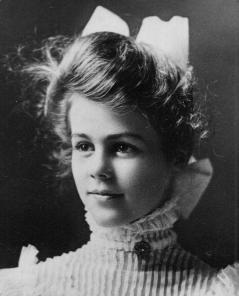
 (Lloyd and Besse join hands and wave) They bought these china pieces
while on their honeymoon in Canada. [Show photo] Lloyd and his father are
partners in James Loonan and Son, raising Percheron horses. When they have
sales they lead the horses to the Cedar Falls Auction Barn. The following
year, in 1912, Besse's grandmother Lydia Molyneux Bedford dies August 4
in Rushmore, Minnesota at the age of 92. (Lydia removes token from map)In
1913, Lloyd and Besse Loonan and their 6-month-old daughter Martha move
to the Thomas Loonan Homestead. This 4-generation photo shows Kate Glenny
Loonan with her son James, grandson Lloyd and great granddaughter Martha.
[Show photo] Lloyd becomes well-known as a breeder of Polled Shorthorn
cattle, and is a member of the Hudson School Board. They had 6 children
during their marriage: Martha, James, Daniel, Ruth, Jean, and Lloyd, three
of whom -- Martha, Jean and Ruth -- are attending this gathering. This
blue willow china was owned by Besse and Lloyd, and this tea set, purchased
in Paris by Besse’s brother Lyman, was also theirs. [Show photos]
(Lloyd and Besse join hands and wave) They bought these china pieces
while on their honeymoon in Canada. [Show photo] Lloyd and his father are
partners in James Loonan and Son, raising Percheron horses. When they have
sales they lead the horses to the Cedar Falls Auction Barn. The following
year, in 1912, Besse's grandmother Lydia Molyneux Bedford dies August 4
in Rushmore, Minnesota at the age of 92. (Lydia removes token from map)In
1913, Lloyd and Besse Loonan and their 6-month-old daughter Martha move
to the Thomas Loonan Homestead. This 4-generation photo shows Kate Glenny
Loonan with her son James, grandson Lloyd and great granddaughter Martha.
[Show photo] Lloyd becomes well-known as a breeder of Polled Shorthorn
cattle, and is a member of the Hudson School Board. They had 6 children
during their marriage: Martha, James, Daniel, Ruth, Jean, and Lloyd, three
of whom -- Martha, Jean and Ruth -- are attending this gathering. This
blue willow china was owned by Besse and Lloyd, and this tea set, purchased
in Paris by Besse’s brother Lyman, was also theirs. [Show photos]
NEWSREADER: In 1912 the Titanic sinks. 1913 sees the development of assembly-line production of cars in the U.S. In 1914 the first world war begins. In 1915 a German submarine torpedoes and sinks the ocean liner Lusitania, killing more than 1,400 men, women and children. In 1917 the U.S. joins the war, and the first American troops are sent to fight with the Allies. Czar Nicholas II abdicates the throne in Russia. In 1918 the Czar and his household are murdered. The U.S. severs relations with Russia. The world war ends. An outbreak of "Spanish flu" kills more than 10 million people around the world.
A U.S. Navy seaplane completes the first flight across the Atlantic in 1919. Jazz is all the rage in America, and prohibition of the sale and consumption of alcohol becomes law in the U.S. In 1920 the U.S. boycotts the first meeting of the League of Nations. The Red Army triumphs in Russia. Women in the U.S. are granted the right to vote when the 19th Amendment to the Constitution is passed.
NARRATOR: In approximately 1920 James and Lizzie Loonan purchase this floor model phonograph, an Edison. [Demonstrate phonograph] These oak chairs, some owned by Jame and Lizzie, and some owned by Lloyd and Besse, are also from this period. [Show chairs] When they were owned by Besse and Lizzie, they had a very dark finish, and the seats were covered with black leather and stuffed with horsehair. This 4-generation photo of Lizzie and her mother Emily Redman Vaughan, her son Lloyd and her granddaugher Jean was taken in 1922. [Show photo]
NEWSREADER: In 1922, Soviet Russia is renamed the Union of Soviet Socialist Republics (USSR). The first radio broadcasting station goes on the air in London. More than 500 radio stations are broadcasting in the U.S. at the time.
NARRATOR: Lloyd's grandmother Catherine Glenny Loonan dies February 28, 1923, in Hudson, Iowa, at the age of 84. (Catherine removes token from map)
NEWSREADER: The first winter Olympics are held in 1924 in France. Metro-Goldwyn-Mayer film corporation is formed by merger in Hollywood, California.
NARRATOR: In 1925, Besse's mother Martha Whiteley Bedford dies June 11 in Black Hawk County, Iowa, at the age of 76. (Martha removes token from map)
NEWSREADER: The first American "motel" opens in San Luis Obispo, California in 1925. The Charleston, the dance that has scandalized America, takes Britain by storm. Biology teacher John Scopes, in the so-called "monkey trial" in Dayton, Tennessee, is found guilty of teaching evolution in a state school and fined $100.
NARRATOR: Lloyd's grandmother Emily Redman Vaughan dies August 3, 1926, at age 90 in Waterloo, Iowa. (Emily removes token from map)
NEWSREADER: In this year, television is demonstrated by Scottish engineer John Logie Baird. Mr. Baird believes that one day there will be a television screen in every home. In the U.S. Robert Goddard is experimenting with the rocket, a scientific tool for exploring the atmosphere above earth. Catholic bishops in Italy are banning scantily-dressed women from church and criticizing women's new involvement in sport as "incompatible" with a woman's dignity.
The first spoken voice is heard in a feature film in 1927; the voice is that of Al Jolson in "The Jazz Singer." Many, including Charlie Chaplin, predict that films with sound will not catch on. Charles Lindbergh makes the first solo flight across the Atlantic in his airplane, the Spirit of St. Louis. Duke Ellington's jazz is being played on the wireless and phonograph all over the U.S. In 1928, Mickey Mouse appears in "Steamboat Willie," the first animated cartoon to have a sound track. Our family enjoyed this film of Mickey in the 1940s. [Show film] Alexander Fleming discovers that a mold called penicillium kills infectious microorganisms, paving the way for development of antibiotic drugs. Al Capone's gang kills 7 members of "Bugsy" Moran's gang in the "St. Valentine's Day Massacre" in Chicago in 1929; the gang killing is attributed to rivalry over the lucrative market in bootlegging liquor. In October, the U.S. stock market crashes.
NARRATOR: Lloyd and Besse Loonan lose their farm in 1927 due to the stock market crash. They move to a farm 2 miles from Cedar Falls for one year. Martha and James attend campus school and Dan, Ruth and Jean go to country school. Lloyd is too young to attend school. Later, Besse and Lloyd buy the Walter Faulkner farm two miles south of Hudson. James and Lizzie Loonan lose their farm about the same time and move to Hudson to the ancestral home of Thomas and Kate Loonan.
NEWSREADER: The Great Depression is in full swing in 1931, with more than 20 percent of the world's workforce unemployed. Franklin Roosevelt is elected president of the U.S. "The Star Spangled Banner" becomes the U.S. national anthem.
NARRATOR: In 1932, Lloyd James Loonan dies February 11 at the age of 45 in Hudson, Iowa, in an accidental shooting. (Lloyd removes his token from map) Besse and her children stay on the farm with the help of a hired man.
NEWSREADER: It's now 1933. As part of his "New Deal" program, FDR persuades Congress to pass the National Industrial Recovery Act, which gives him power to control industry, bring unions and bosses together, shorten working hours, fix wages and regulate production. $3 billion are being poured into public works programs, including the Tennessee Valley Authority and the civilian conservation corps. A million new jobs will be created. His regular "fireside chats" on the radio are listened to by millions. He has repealed prohibition laws. "I think this would be a good time for a beer," he tells Congress.
In Germany, Adolf Hitler becomes chancellor and declares the Third Reich. Hitler orders a boycott of Jews and Jewish shops. There is growing violence throughout Germany as the Nazi party terrorizes Jews and others who disagree with their politics. A concentration camp is opened at Dachau.Radar is invented in England in 1935. In the U.S. President Roosevelt signs the Social Security Act, introducing welfare for the old, sick and unemployed. In 1937, the British announce plans to partition Palestine, to form a national homeland for Jews. The synthetic fiber nylon is invented, as is the Polaroid camera, which makes it possible to produce a positive print without taking the negative out of the camera. The dirigible Hindenburg, the pride of the German airship fleet and veteran of 10 successful transatlantic trips, burns as she comes in to land in New Jersey, killing 35 passengers and crew. Amazingly, some survived.
The first jet engine is developed in 1938.
NARRATOR: In 1938, after Martha Loonan marries Harold Nation and they move to the farm, Besse Loonan leaves the farm and moves to Hudson to live in an apartment in James and Lizzie’s home. This photo of Besse and her brothers and sisters was taken in 1938 in Lake Ada, Minnesota. [Show picture]
NEWSREADER: Scientists in Germany split atoms for the first time in 1939, releasing enormous amounts of energy in the process. Germany invades Poland, and Britain and France declare war on Germany. The Second World War begins. In 1941, Japan bombs Pearl Harbor, and the U.S. declares war on Japan, Germany and Italy.
NARRATOR: In 1942, James Loonan dies May 28 at age 81 in Hudson, Iowa.
NEWSREADER: In 1944, DNA is discovered by Oswald T. Avery in New York. The Allied troops land on the beaches of Normandy in the biggest land, sea and air operation of all time -- D-Day. In May, 1945, Germany surrenders to the Allies. Atomic bomb tests occur in New Mexico, and the first atomic bombs are dropped on Japan later that year, ending the second world war. The first electronic computer, the Atanosoff-Berry Computer (ABC) is developed at Iowa State University.
In 1946, the first civilian airflight occurs in Britain, and the first rocket to leave the earth's atmosphere reaches a 50-mile height. The first session of the United Nations opens in London. Former British prime minister Winston Churchill warns that an "iron curtain" has descended across the European continent, referring to seemingly irreconcilable ideological barriers between the Western capitalist world and the Eastern, Communist world. A scientist in the U.S. claims that smoking could be a cause of lung cancer.
NARRATOR: This photo of Besse and her children was taken in 1946 shortly after sons Jim and Lloyd returned from the war.
NEWSREADER: In 1947, the U.S. announces the discovery of plutonium fission, suitable for nuclear power generation. Chuck Yeager becomes the first man to travel faster than sound, as his rocketplane exceeds 760 miles per hour. American secretary of state George Marshall announces an ambitious plan to assist European countries' economic recovery. Bell Laboratories develops transistors, which are destined to replace vacuum tubes.
The new state of Israel is formed in 1948. RCA announces the invention of a system for broadcasting color television. In 1949, the U.S. and Western Europe form the North Atlantic Treaty Organization (NATO), a collective defense alliance. Chinese leader Mao Tse Tung announces the formation of the People's (Communist) Republic, with Chou En-Lai as premier.
NARRATOR: In 1952, Lloyd's mother Elizabeth Vaughan Loonan dies March 17 in Hudson, Iowa, at the age of 88. (Lizzie removes token from map) Besse Loonan moves into a smaller house of her own in Hudson, built by Taylor and Isenhower.
NEWSREADER: The first space satellite, Sputnik, is successfully launched by the USSR in 1956. The Soviet Union also wins the race to place a man in space by sending Yuri Gagarin into orbit and bringing him safely back to earth in 1961.
In 1963, U.S. President John Kennedy is shot and killed. The Beatles -- a rock group from Liverpool -- are popular in Europe and America. The U.S. becomes heavily involved in the war in Vietnam in 1965. The miniskirt becomes popular. "Flower children" wearing bell-bottom pants and love beads are seen frequently in 1967. Martin Luther King and Robert F. Kennedy are killed by assassins. In 1969 astronaut Neil Armstrong walks on the moon, and thousands of "hippies" flock to New York for the Woodstock Music and Arts Fair. It's a happening, man!In 1970 the first Boeing 747 jumbo jet flies from London to Frankfurt. In 1972, President Richard Nixon signs an agreement with the USSR to limit nuclear arms. Seven men, including 2 former Nixon White House aides, are indicted for breaking into the Democratic National Headquarters in Washington, D.C.'s Watergate complex; this will lead to the first U.S. presidential resignation in history.
NARRATOR: On November 13, 1972, Besse Loonan dies in Reinbeck, Grundy County, Iowa at the age of 85. (Besse removes her token from map) In the Hudson Cemetary, where the Loonans are buried, there is a unique coincidence. There are 6 family members whose dates of death end in the number 2. Lloyd 1932, James 1942, Robert Nation (son of Martha and Harold) 1942, Lizzie 1962, Besse 1972, Hank Thompson (husband of Ruth) 1982. And Bernadine Loonan (wife of Dan), who is buried in Ames, Iowa, 1952.
With the passing of Besse Bedford Loonan, we end our dramatization
of the life and times of Lloyd and Besse Loonan and their forebears. But
that isn't the end of the drama. Lloyd and Besse live on in the memories
of those gathered here today. Their children and grandchildren and great
grandchildren, God willing, will continue the Bedford/Loonan story in the
days to come. To all of you who are watching this tape, our message is:
Carry on! (Actors converge and wave to camera)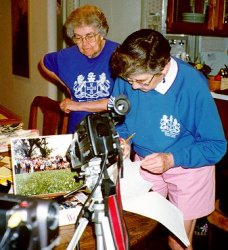
Props:
Coverlet, Pine box, End table, Bedford family bible (1804), Lizzie Loonan's bible (1878), Lizzie Loonan's quilt, Lizzie Loonan's butter paddle, Lloyd Loonan's China head doll, Record player, Chairs, Pastel painting of Besse and Helen, Other photos, Map (British Isles to U.S.) and tokens or pins for each player to move on the map.